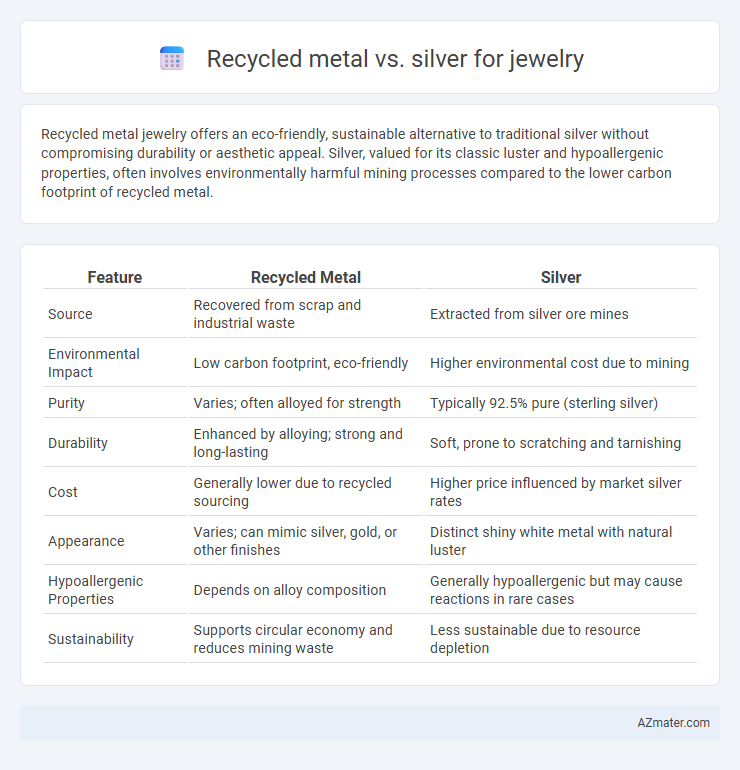Recycled metal jewelry offers an eco-friendly, sustainable alternative to traditional silver without compromising durability or aesthetic appeal. Silver, valued for its classic luster and hypoallergenic properties, often involves environmentally harmful mining processes compared to the lower carbon footprint of recycled metal.
Table of Comparison
| Feature | Recycled Metal | Silver |
|---|---|---|
| Source | Recovered from scrap and industrial waste | Extracted from silver ore mines |
| Environmental Impact | Low carbon footprint, eco-friendly | Higher environmental cost due to mining |
| Purity | Varies; often alloyed for strength | Typically 92.5% pure (sterling silver) |
| Durability | Enhanced by alloying; strong and long-lasting | Soft, prone to scratching and tarnishing |
| Cost | Generally lower due to recycled sourcing | Higher price influenced by market silver rates |
| Appearance | Varies; can mimic silver, gold, or other finishes | Distinct shiny white metal with natural luster |
| Hypoallergenic Properties | Depends on alloy composition | Generally hypoallergenic but may cause reactions in rare cases |
| Sustainability | Supports circular economy and reduces mining waste | Less sustainable due to resource depletion |
Introduction: Understanding Jewelry Materials
Recycled metal in jewelry offers an eco-friendly alternative by repurposing scrap metals, reducing mining impact and conserving natural resources. Silver, a traditional choice, is prized for its durability, shine, and hypoallergenic properties, often used in fine and fashion jewelry. Comparing recycled metal and silver involves assessing factors such as environmental benefits, metal purity, and overall aesthetic appeal.
What is Recycled Metal in Jewelry?
Recycled metal in jewelry refers to precious metals like gold, silver, and platinum that are reclaimed from existing products, scrap, or industrial waste and refined for reuse. This process reduces environmental impact by minimizing the need for new mining, conserving natural resources, and lowering carbon emissions. Unlike newly mined silver, recycled silver maintains the same quality and purity while promoting sustainable and eco-friendly jewelry production.
Silver: Properties and Popularity
Silver remains a leading choice for jewelry due to its excellent thermal and electrical conductivity, malleability, and bright, reflective luster. Sterling silver, an alloy containing 92.5% pure silver, is favored for its durability and affordability compared to recycled metals. Its timeless appeal and hypoallergenic properties contribute significantly to its ongoing popularity in fine and fashion jewelry markets globally.
Environmental Impact: Recycled Metal vs Silver
Recycled metal in jewelry significantly reduces environmental impact by minimizing mining activities that cause habitat destruction, soil erosion, and water pollution. Silver mining, while valuable, involves energy-intensive processes and releases harmful chemicals like cyanide and mercury, increasing ecological risks. Choosing recycled silver lowers carbon emissions and conserves natural resources, making it a sustainable alternative for eco-conscious jewelry production.
Durability and Quality Comparison
Recycled metals, often sourced from scrap and melted down to create new materials, typically maintain comparable durability to silver but offer enhanced environmental benefits. Silver, especially sterling silver with its 92.5% purity, is renowned for its lustrous finish and malleability, making it ideal for detailed jewelry designs, but it can tarnish over time requiring regular maintenance. While both materials ensure quality craftsmanship, recycled metals may include various alloys that influence hardness and wear resistance, potentially outperforming pure silver in terms of scratch resistance and longevity.
Aesthetic Differences in Design
Recycled metal jewelry often features unique textures and patinas that result from the metal's prior use and melting process, giving each piece a distinct, eco-conscious aesthetic. Silver, prized for its bright, shiny luster, allows for high-polish finishes and intricate, detailed designs that emphasize elegance and classic beauty. Designers choose recycled metal for its rustic, organic appeal and silver for its timeless, refined look, catering to different stylistic preferences in the jewelry market.
Cost and Affordability Factors
Recycled metal for jewelry offers a more affordable alternative to silver due to lower sourcing and processing costs, making it attractive for budget-conscious consumers. Silver's market price can fluctuate significantly based on global demand and purity, resulting in higher and less predictable expenses. Choosing recycled metals reduces environmental impact while maintaining reasonable pricing, balancing cost-effectiveness with ethical considerations in jewelry production.
Ethical Considerations for Consumers
Recycled metal offers a significantly lower environmental footprint compared to mining silver, reducing habitat destruction and minimizing toxic waste. Silver mining often involves harmful practices such as the use of cyanide and mercury, which pose serious ethical concerns regarding both ecological damage and worker health. Consumers seeking ethically responsible jewelry should prioritize recycled metals to support sustainable sourcing and reduce the demand for newly mined silver.
Trends in Sustainable Jewelry
Recycled metal jewelry has gained significant traction in the sustainable fashion industry due to its reduced environmental impact compared to traditional silver mining, which often involves energy-intensive processes and potential ecological harm. Brands increasingly promote recycled silver, highlighting its ability to maintain the lustrous appearance and durability of new silver without depleting natural resources. Consumer demand for eco-friendly alternatives drives innovation in recycled metal sourcing, making it a leading trend in sustainable jewelry design and production.
Choosing the Right Material for Your Jewelry
Recycled metal offers an eco-friendly alternative to traditional silver, reducing environmental impact through sustainable sourcing and lower energy consumption. Silver remains valued for its timeless luster, hypoallergenic properties, and affordability, making it a classic choice for fine jewelry. When choosing the right material, consider factors such as sustainability goals, budget, and desired durability to ensure a balance between ethical impact and aesthetic appeal.

Infographic: Recycled metal vs Silver for Jewelry
 azmater.com
azmater.com